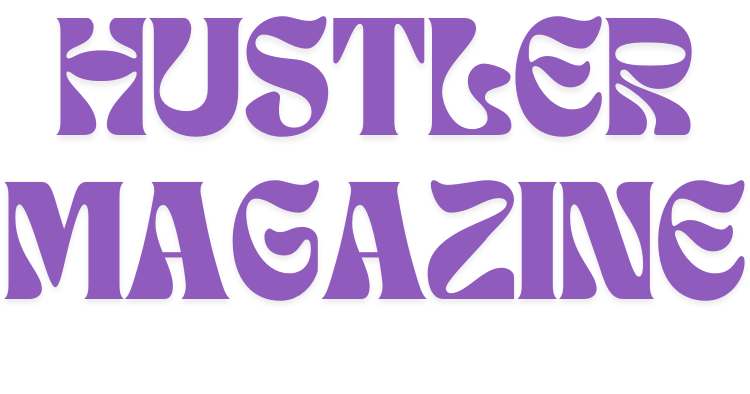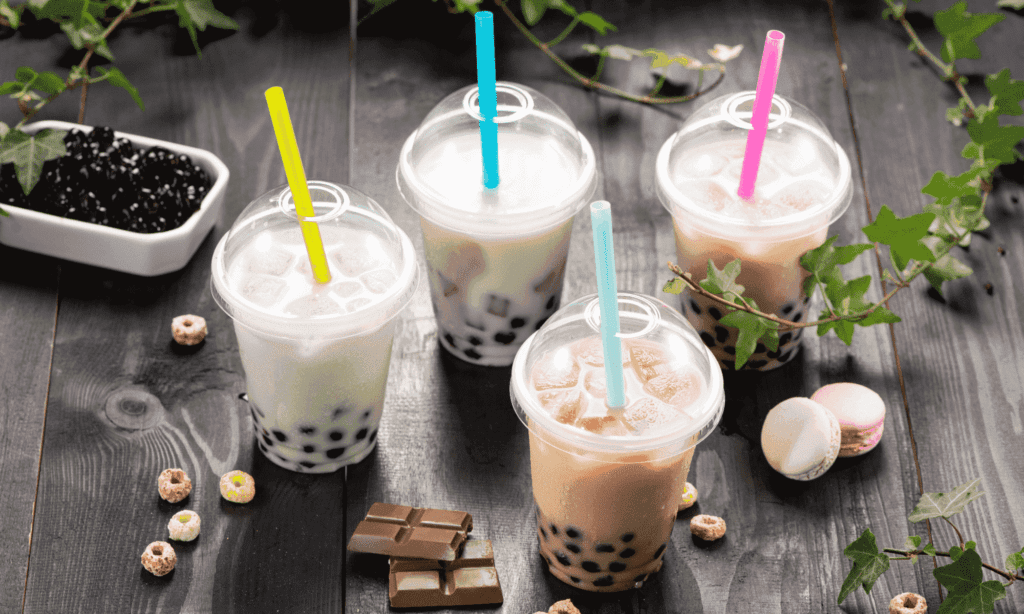A drink with tapioca pearls or fruits.
That’s just the tip of the iceberg. If someone mentions ‘Boba Tea’ they’re referring to a traditional cold-served drink that contains a base of tea, milk or fruit flavors, and edible pearls inside the cup (the ‘boba in boba).
Many people are confused by the many names of boba tea. If you’ve heard any of the following terms, they mean exactly what it says: bubble, tapioca, or boba tea.
Boba Tea is become more popular in recent years. The unique and new experience of drinking a drink with edible pearls is largely responsible for this.

Tapioca Boba
Tapioca pearls, made from starch, are served as part of the traditional milk boba.
It is a mixture of tea, milk and sugar. However, there are many variations. The Boba Tea is offered in both a hot and iced version. The tea is usually served in plastic cups with wide mouths and wrapped up in clear plastic. Refer to the picture.
The traditional boba is found in the bottom of cups and they are chewy.
They are available at any time of day and have a consistency similar to that of jell-o and chewing gum (no gelatin). The majority of tapioca is black. However, there are some that are transparent and white.
Popping Boba
The fruit-based boba is usually ordered in combination with the popping boba.
These spheres are filled with fruit and have a skin that is similar to gel. The name comes from the fact that popping boba explodes in flavor upon being squeezed. The traditional ingredients of popping boba are seaweed, calcium compounds and fruit juice.
Jelly Topping
Jellies are another popular topping. The jelly is a rectangular chewy fruit flavoring that looks like jell-o. The toppings can be made with Konjar, a vegetable by-product or coconut meat. Jellies, besides their delicious taste, are also popular for having zero cholesterol and high fiber.

Who is the inventor of boba?
Two separate teahouse employees in Taiwan during the 1980s.
First Origin Story
Two main tales are told about the origins of boba. According to one story, the origins of bubble tea can be traced to Taiwan in the 1980s, where Ms. Lin Hsi Hui added the tapioca from her Taiwanese sweet to her iced boba tea.
After a trip to Japan her boss Mr. Liu Han Chieh, the tea room owner, had begun to serve iced tea, but had no intention of changing the recipe.
When coworkers of Lin Hsi Hui noticed that she had added tapioca to her iced-tea, the drink became incredibly popular amongst staff. Han-Chieh, the owner of Han-Chieh’s shop, added this drink to their menu after recognizing how popular it was in-store. It quickly became the most popular drink in the tearoom.
Second Origin Story
According to the other story, Tu Tsong He, a Teahouse Owner in Tainan in Taiwan was inspired by white tapioca ball after seeing it in a market to add them to his tea.
The boba looked similar to precious stones in black tea, so he began calling the tea “pearl Tea”. Soon, he added brown sugar and honey to sweeten the tea and offered his customers black tapioca.
We cannot say for sure which person was the original inventor of bubble tea. However, these experiments led to a world-changing idea.
Taiwan now has hundreds of Boba Tea shops. Bubble tea has grown to include a variety of flavors, as well as add-ons like pudding, jelly, popping boba and boba.
In 2019, the boba market was valued at $2.4 billion. This is projected to increase by $2 billion over the next seven years. What a great sign for fans of boba!
Due to the growing popularity of boba, many products have been created that enhance the boba experience. The typical straws we use in everyday life, for example are not thin enough to let the boba pass through.
The rise in popularity of bubble tea led to a need for larger straws. A wide range of reusable metal straws were produced for boba lovers by the stainless steel market and eco-friendly industries. What big changes will boba bring next?

Why has boba become so popular?
1. Enjoy a unique taste experience
Bubble tea has a unique drinking experience. To begin, you first need to puncture the plastic cup top with a straw that has a large mouth.
You can then enjoy chewy pearls or burst ones in your mouth while drinking tea. It sounds a little different than slurping down a smoothie at smoothie king.
2. Variety of toppings and flavors
The base of boba tea can be either milk or fruit. Bubble teas can be very different and unique.
These include: original milk, matcha (green tea), taro (honeydew), strawberry, passion fruit, lime, watermelon and grapes, as well as lychee, peach pineapple, cantaloupe honeydew banana avocado coconut kiwi. Boba tea’s toppings are what make it so special. Toppers include jelly, pudding, boba and popping boba.
3. The Aesthetic is Primed for Social Media Share
Boba tea looks quite unique. Now that you know, we can also tell you. This is part of what makes boba so appealing. Many customers have shared their Boba Tea on social media, showcasing the drink’s uniqueness.
There are many varieties of boba. They love sharing their custom boba choice on Instagram, Facebook and Snapchat.
Is boba tea unhealthy?
It depends what kind of boba you choose.
Traditional bubble tea, contrary to popular belief, is not healthy. According to Healthline bubble tea is high in sugar, fat, and calories.
Healthline states that drinking bubble tea is nearly as sweet as soda. Milk bubble tea is one of the many types of bubble-tea. Sugar content of milk bubble tea is particularly high.
Many people assume that boba is healthy because they know tea.
These assumptions can be true – benefits from traditional tea are primarily antioxidants. They include better brain function, protection against cancer, weight loss, and reduced risk of heart attack.
Green tea also contains plant chemicals that help reduce inflammation, and protect cells.
If tea and milk are both good for us, then wouldn’t you love boba tea? Incorrect. In many instances, bubble tea is viewed as a dessert or ‘guilty treat’ due to its high sugar content.
Many fruit bobas teas sold in local boba shops contain artificial sweeteners, as well as syrups that are filled with other ingredients. These additives serve to enhance the flavor of the beverage.
As Tapioca Pearls is starch, it has a high calorie content (100 calories per cup of Boba Tea). You can clearly see that boba is unhealthy when you look at everything other than the tea.
Boba is vegan?
Ask an employee for the short answer. Some cups are not.
The typical milk boba is made from tapioca, a type of starch. It contains no gelatin. Making boba yourself is a great way to maintain a healthy vegan diet.
The popping pearls used in the fruit boba drink are also made from seaweed extract, a calcium-based compound and no gelatin. Fruit flavoring is created by a syrup or puree in the beverage.
The milk itself will be the one component you may find that is not vegan.
Many boba shops also use vegan milks such as almond, nut or oat. It is important to ask the employee. Some stores use milk that is not vegan.
Most boba shops also offer milk substitutes that are vegan-friendly, so you don’t have to worry about your diet. Bottoms up, everyone!

What is the origin of tapioca or boba, which you find in bubble tea?
Tapioca’s history is easier to understand than the long and winding one of boba. Tapioca, the primary ingredient of traditional milk-based tea, is used to make boba.
This starch is extracted from the cassava root. Cassava is native to Americas but now it’s grown all over the tropical world including Africa, South America and Southeast Asia.
In 1544, the first use of tapioca in Europe was recorded. In 1544, the Portuguese introduced cassava into Africa where it was grown and flour made.
Tapioca was made in Asia from the flour. Tapioca was popular in South Asia and Southeast Asia for centuries. However, it wasn’t the only pudding made from starch.
The 19th century saw the popularity of starch-based desserts in Europe and North America, such as tapioca. Sago, a native Asian starch, was popularized in the English version of this pudding.
We don’t have an exact date for the invention of tapioca pearls. However, it is known that they were invented on the Southeast Asian islands (Brunei and Indonesia as well as Malaysia, Singapore, East Timor, Philippines, Malaysia).
Taiwan is where it was first used to create boba tea. It’s a popular ingredient in many dishes, as if to enhance the taste and texture. It was here that it first became boba, a milk tea infused with shaved ice.
What is ‘boba,’ the ingredient in boba?
Tapioca is derived from cassava. Making tapioca ball involves cutting cassava roots into smaller pieces and boiling them for 30 minutes, or until they become soft enough to extract the juice.
Tapioca is made from the juice extracted from cassava roots. The tapioca ball is sun-dried and packaged after the cassava root juice has been extracted.
People often wonder about the different ways that tapioca is shaped. Tapioca is shaped into various shapes using a variety of tools.
Tapioca can be cut into different shapes, such as cubes or flowers, using the cube cutter. Tapioca is stored for 2 days in the refrigerator before it can be used to make a beverage.
Make boba in your own home!
You now know almost everything about how to make boba.
Let’s begin with the materials. You’ll want to first choose the ideal topping for your boba. We’ll be using a tapioca sphere for this particular example.
Purchase a package of bubble tea Pearls. You can easily find them on Amazon or Walmart. You’ll also need your favorite tea, some milk, brown sugar and fruit pulp (if you like).
- 1. Pour water into a large pot, add your favorite tea and turn the heat to high. This should be brought to a rolling boil. Remove the pot, and allow the tea to cool down until it is at room temperature.
- 2. Fill a second medium pot with water. Wait until the water boils and heat it up on high. Add the tapioca to boiling water and let it boil for 15-20 minutes. Check after 10 minutes to see if the pearls have softened.
- 3. Pick up the pearls and then drain them using a strainer
- 4. Put the strainer with pearls over a bowl. Pour the boiling water on top of the brown sugar in the strainer.
- 5. The brown sugar should dissolve when the pearls are stirred. Allow the pearls to soak for 30 minutes in the syrup of brown sugar, and then set them aside until they are ready.
- 6. Pour the tea and milk into the glasses. Add the sugar and brown syrup.
- 7. Stir up, grab your straw and have fun!

Where can I buy bubble tea?
Searching on Google for ‘boba stores near me’ is the easiest way to find boba. Most boba is sold in boba shops that are specialized.
Some boba stores are’mom-and-pop’ or franchises. Many asian supermarkets and restaurants sell the beverage in a fresh form or a canned version.
In many US states, bubble tea is a popular drink. California is home to more than half the U.S. boba-tea stores.
There are also newer innovations in boba, such as the goba brand of boba that is sold online. It contains a healthier boba. Search boba-to-go on Google to see all the portable options for boba!
Conclusion
Boba Tea was invented in the 80s, and has grown in popularity since then. It is more than just a “fad” for several reasons. Boba tea is gaining popularity every day, and the growth rate for this product should be just under 8% per year. Over the next seven year.
The milk-based and fruit-based beverages created a new category and offered a completely novel experience.
Boba tea is enjoyed by people of all ages, even though the majority of its customers fall between 18 and 35 years old. The chewy, bursting taste of boba is loved by everyone from young children to grandparent.
We are boba fans ourselves and believe that the full potential of boba has yet to be realized. It has reached new audiences, but has grown in popularity over the years.
Next time we look at our social media, let’s see if you share your first bottle boba!
Cheers!



